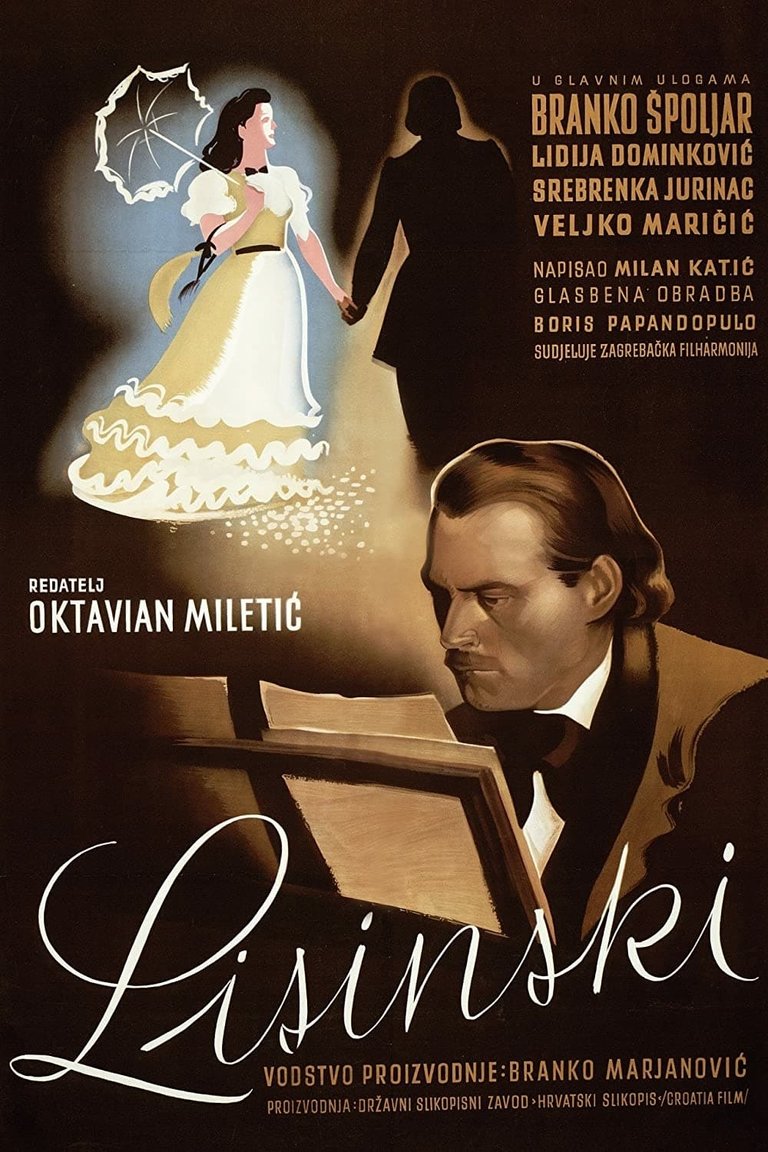Film Review: Lisinski (1944)

Complicated 20th-century history and a different set of criteria lead to many different answers to the relatively simple question, 'Which is the first feature film in the history of Yugoslav cinema?' The issue is much clearer in the case of Croatian cinema, but Lisinski, a 1944 biopic directed by Oktavijan Miletić, has spent many decades in total obscurity due to those very same complicated historical circumstances.
The film was made during the Second World War, when the territories of former Yugoslavia were occupied by Nazi Germany and other Axis Powers. This included Croatia, where the Nazis installed a puppet regime known as the Independent State of Croatia, led by the fascist Ustasha movement under Ante Pavelić. The regime devoted considerable resources to propaganda, which facilitated the rapid development of the nascent film industry and a studio called Hrvatski slikopis. Lisinski was its first live-action feature film and the only one completed before the end of the war and the regime, which was replaced by the victorious Yugoslav Partisans.
The plot begins on May 22, 1943, in the Croatian capital of Zagreb, when the Croatian State Theatre stages a gala concert of works by Vatroslav Lisinski, a 19th-century Croatian composer known as the author of the first Croatian opera. Boris Papandopulo, the conductor (who also composed the film's soundtrack), addresses the audience, emphasising Lisinski's importance to the development of Croatian culture and how he was misunderstood and unappreciated during his lifetime. The narrative shifts to 1841, when Croatia is under Habsburg rule. Lisinski (played by Branko Špoljar) works as a lowly government clerk, barely finding time to pursue his true passion for music. His friend Ognjen Štriga (played by Veljko Maričić), an enthusiastic supporter of the Illyrian movement, encourages him to write music using the lyrics of Croatian patriotic poems. These songs gain popularity, not only among patriotic youth but also among segments of the aristocracy, including Countess Sidonija Erdödy Rubido (played by Srebrenka Jurinac), an opera singer. Lisinski undertakes the ambitious task of composing Love and Malice, which will become the first Croatian opera. Encouraged by his love for Hedviga Ban (played by Lidija Dominković), he continues to work on his next opera, Porin. However, the envy of politically connected yet untalented peers, coupled with his declining health and increasing financial troubles, conspire to end Lisinski's career, leaving him to spend the last years of his life as a broken man.
Director Oktavijan Miletić, one of the pioneers of Croatian and Yugoslav cinema, was the most experienced filmmaker at the time, having made a number of quality short films before the war. His direction of Lisinski is confident, making excellent use of the resources available to him and rendering his film stylistically and technically indistinguishable from high-budget productions of other European cinema industries of the time. Scriptwriter Milan Katić, while celebrating Croatian patriotism, avoids the politics of the World War II era and focuses on a figure who lived a century earlier; however, some “problematic” details from Lisinski’s life were removed to conform to the ideological parameters of the Ustasha regime, such as Lisinski’s real name, Ignac Fuchs, which indicates his Jewish background, as well as his brief involvement in the Revolutions of 1848 and attendance at the Prague Slavic Congress.
The most disappointing aspect of Lisinski is the casting. Branko Špoljar possesses the looks of a film star and is made to resemble Lisinski from historical paintings, yet he portrays the character as incredibly passive and almost pathetic, in contrast to Veljko Maričić, who steals the show as his passionate and enthusiastic friend. Lidija Dominković’s theatrical acting style is poor, while Srebrenka Jurinac (who would continue her career as Sena Jurinec in post-WW2 Austria) performs energetically in musical numbers. The main issue with Lisinski is the lack of events or drama in the protagonist's life; Miletić adds long shots of Lisinski walking through streets, forests, or hills merely to pad the running time. Conversely, there is a palpable enthusiasm among the crew and cast when reconstructing certain aspects of the past, such as in the ball scene.
Despite these limitations, Lisinski is a good film that provides an interesting insight into Croatian history. Thanks to Milan Katić's involvement in the antifascist resistance, its cast and crew not only survived the collapse of the Independent State of Croatia but also continued their careers in Communist Yugoslavia, sometimes with great success. However, their work in this pioneering piece of Croatian cinema was “memory holed” for ideological reasons, becoming available to the public only in 1990, after the end of the Communist regime.
RATING: 6/10 (++)
_
Blog in Croatian https://draxblog.com
Blog in English https://draxreview.wordpress.com/
InLeo blog https://inleo.io/@drax.leo
InLeo: https://inleo.io/signup?referral=drax.leo
Unstoppable Domains: https://unstoppabledomains.com/?ref=3fc23fc42c1b417
Hiveonboard: https://hiveonboard.com?ref=drax y
Bitcoin Lightning HIVE donations: https://v4v.app/v1/lnurlp/qrcode/drax
Rising Star game: https://www.risingstargame.com?referrer=drax
1Inch: https://1inch.exchange/#/r/0x83823d8CCB74F828148258BB4457642124b1328e
BTC donations: 1EWxiMiP6iiG9rger3NuUSd6HByaxQWafG
ETH donations: 0xB305F144323b99e6f8b1d66f5D7DE78B498C32A7
Posted using CineTV
Seems you are really intrigued by sharing some old movies😀. You really make me remember some old times